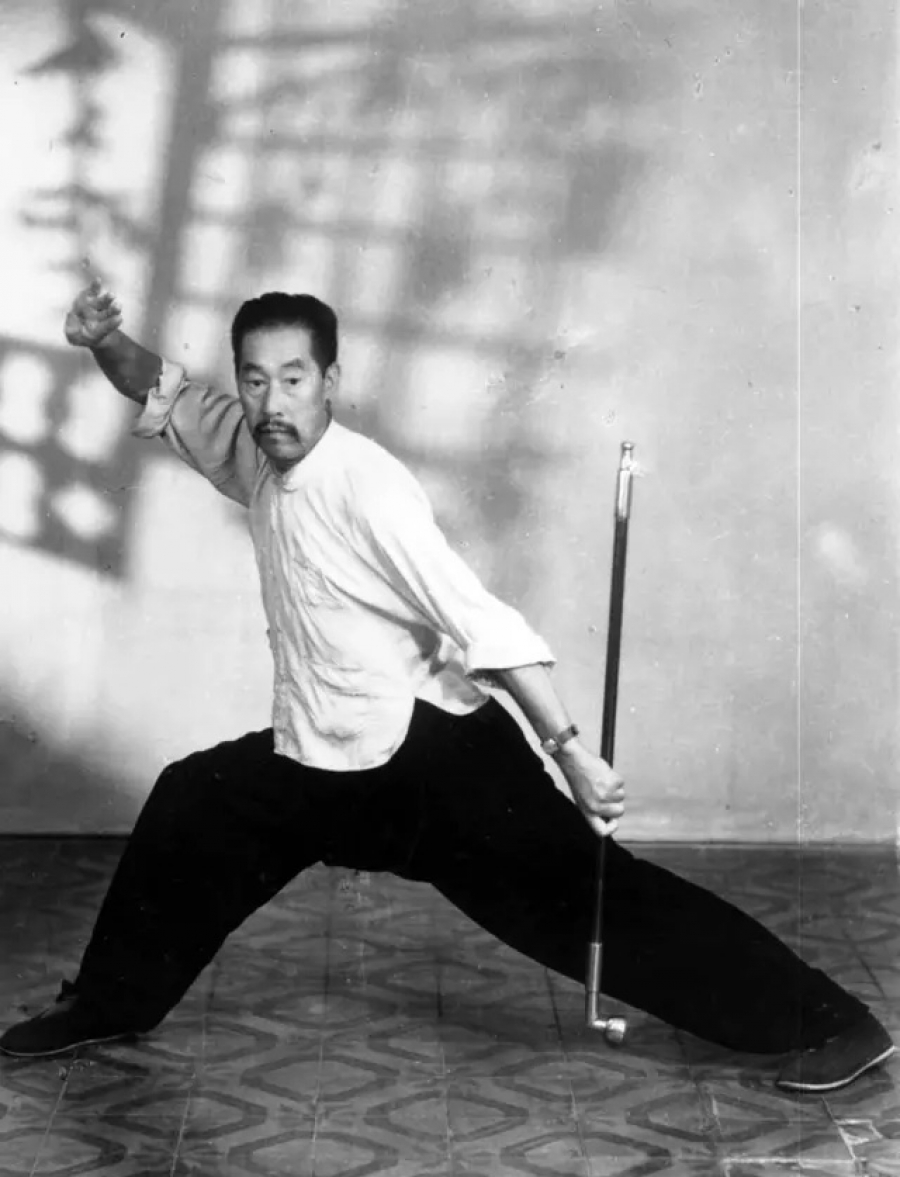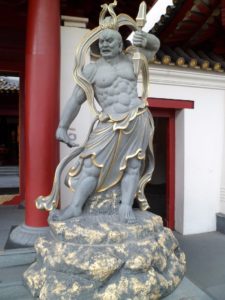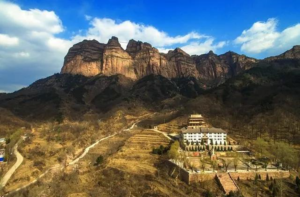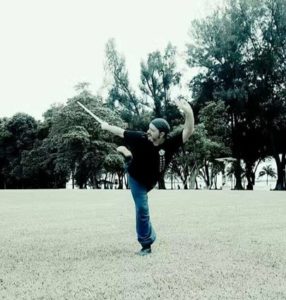Chuojiao Fanzi Quan (戳脚翻子拳), is the name of Chuojiao from the capital, Beijing of China. It has evolved into distinct features with much of this attributed to its renowned masters. Chuojiao is one of the older boxing methods of China, known for its comprehensive martial skills which emphasize both kick/legs and hands, as well as ground fighting (Ditanquan). In Li County, Hebei Province the great Master Feng Keshan (冯克善), was the private instructor of the Liu family household (of which Liu Guanlan was most renowned), at which time he also took on other disciples from the town. One such disciple was Wei Changyi.
Wei Style Chuojiao
In the martial world the three generations of renowned Chuojiao masters all heralded from the same village. M. Wei Changyi, M. Wei Xankui and M. Wu Binlou were from the Qizhuang Village of Li County in Hebei Province. Wei Changyi was working as a Biao Shi (security officer) of the Fuyuan Biao Shi (福源镖局). The Fuyuan Logistics Security Bureau was opened by the renowned Chuojiao M. Liu Guanlan.
The Imperial Bodyguard – “” Wei Changyi
Wei Cangyi (魏昌义) was from Jijiazhuang (Jijia Village) in Lixian and when Feng Keshan was in Lixian as the instructor of the Liu family in nearby Zhaoduanzhuang, Wei Changyi sought out Master Feng and studied the great art of Chuojiao. Master Wei also travelled to nearby Shanxi province and had picked up skills of various other martial arts. He became a well-known martial artist, a famous Biaoshi (Security escorted Logistics Expert) and also was employed as bodyguard for the imperial family. As a result of these posts/careeers, Wei Changyi did not have as many disciples, but did become a renowned fighter. A sample incident is when a famous Xingyi Master Li Fuzhen had a friendly challenge with Wei Changyi, and was so impressed by the powerful kicks of Chuojiao, that he asked Wei Changyi to teach him some methods. Li Fuzhen then developed a set of Yuanyangquan which he incorporated into his branch of Xingyiquan.
The Imperial Legend – “Iron Leg” Wei Zankui
Wei Zankui (魏赞魁,1854-1951) was the nephew of Wei Chanyi, who studied daily with the great Master for over 10 years and became an expert of the style. There are many legends of Wei Zankui including one in 1900 when the 8 foreign nations inv aded Tianjin, 20,000 Qing soldiers were sent to battle the invaders at Tongzhou Zhangjia Bay. Since Wei Zankui was so skilled in battle he became a captain and led the soldiers to victory, forcing the foreign armies to retreat. The Foreign armies returned with a greater expanded force. Generals of the Qing armies such as Ma Yukun, Chen Zilin, Zhang Chunfa and others abandoned the battle. Only general Li Binheng was trapped and surrounded. Wei Zankui then led the remaining armies to battle all night long to find a way to out manoeuvre the foreign armies. Wei Zankui with his Yue Dang(Moon Knives) protected the general Li and the armies to safety. He earned great merit for this feat. After returning to the imperial palace, he also protected the Empress Dowager Cixi to safety to the west of the imperial palace. Again earning merit for his bravery. As a result of these achievements he achieved a great rank (Si Jing Daidao) and Chuojiaofanzi became respected as Yu Fanzi (‘Yu’ used for imperial purposes, 御翻子).
Wei Zankui was a very direct and did not engage in flattery, once upon a time he travelled to Guanghelou to watch a performance of classical chinese opera and after a dispute with Huang Daizi (a royal family member), he killed one of the parties with the royal family member. As a result he was sent to the army front as punishment. On the way, his group was ambushed and as result, Wei Zankui did not end up going to the front and decided to leave service returning to his birth home in Li County.
After leaving his post, Wei Zankui returned to Li county where he lived in seclusion and accepted some disciples and taught many his Chuojiaofanzi. Wei Zankui was an extraordinary martial artist and therefore gained the nickname if “Iron Leg”, he not only could move trees off their roots with a kick but could also withstand iron or cart rolling over his legs.
Even at the advanced age of 94, he could still demonstrate his Chuojiao and ditangquan which includes many aerial tumbles and falls with ease. In 1950, when Wei Zankui was 97 years all his friends and students celebrated his birthday and as a result of his excitement as he stood up to perform some routines of Chuojiao and fell accidently, he felt useless in his age not being able to perform his skilled martial art. Not long after, he passed away. There were countless thousands that came to mourn his passing from all the villages around and all the streets were blocked when his coffin was moved through the towns.
Wei Zankui’s disciples included: Wei Xing, Wei Youcai, Wei Xishen, Wu Zhentang, Xiao Chunrong and Wu Binlou. In Li county, the descendants of Wei Zankui which were the majority of the disciples above practiced what is referred to as Li County Chuojiao. An exception was Wu Binlou who taught many in Beijing, his style thereafter referred to as Beijing Chuojiaofanzi.
Beiping Chuojiao Master – “Flower Whip” Wu Binlou
Wu Binlou (吴斌楼, 1898-1977) was born on the 12th December 1898 in Qijiazhuang, Li county western bridge district with the Baoding municipality. Li county is recognised as one of the Chuo Jiao martial arts area of concentration and practice. In 1905 Wu Binlou at the age of 6, he commenced the practice of Chuojiao with tutelage from “Iron Leg” Wei Zankui, at the same time he commenced his general education. He studied for ten years Chuojiao, Cunfanzi, Xiaofanzi, Dafanzi, Kaozhanlian and Weapons. In addition he was fortunate to be taught some methods from his grandmaster Wei Chang Yi (Direct Disciple of Feng Keshan).
In 1915, Wu Binlou followed his father to Beijing assisting in the family business. In addition to helping the business, he also trained his martial arts daily. In 1920, he became the Bureau Teacher for the Ren Mau Biao Jue (Ren Mau Security Bureau). In olden days, security bureaus were used to transport goods, property and offer escort security services. They hired the best martial artists to ensure their reputation was maintained. It is during this time that Wu Bin Lou earned the name as “Hua Bian” (Flower Chain Whip) Wu Binlou.
In 1921, the bureau closed down as a result of changes to the economic structure of the region and of commercial enterprising. Since Wu Binlou always intended to complete his studies he returned to Li county in Hebei province and followed his master Wei Zankui in progressing and analysing the deeper aspects of Chuo Jiao. He progressed quickly and improved his knowledge and skill considerably.
Master Wu Binlou was a great talent and at not even thirty years of age grasped the essence of the martial arts, and his uniquely specialised Chuojiao Fanzi was heard across the martial world. In 1935, he was honored amongst other great martial artists such as Heng Shoushan, ZhaoXinyuan, Liu Desheng, Liu Yueting (Qi Family Tongbeiquan), Wang Rongbiao and Shang Yunxiang (Xing Yi Quan) – as the 10 experts of martial arts in Beijing. In that same year, Wu Binlou whilst in Nanjing met with a master Yao Zhiguang from Hubei Province who was descendant from Yao Zhenfang, whom was associated with Wei Changyi from earlier times. This was a great meet and the two masters Wu Binlou and Yao Zhiguang spent much time together researching to re establish the 18 sets of Yanqing Fanzi further enhancing the repetoire of the style. This project was not completed but in addition to Wu binlou adding the set from Yao Zhiguang and one newly created, he also created an additional 9 sets (totalling 11) under the title Yanqing Fanzi Quan.
In 1939, the Japanese armies had encroached parts of Northern China and Wu Binlou was tasked with leading a delegation to Japan to participate in Martial Arts competitions. At the time many martial arts colleagues had tried to persuade him no to go mainly out of concerns of being misinterpreted as support to the Japanese. Wu Binlou thought for long over the matter and finally decided to go proclaiming “This time travelling eastward the intentions are complicated and difficult to assess, irrespectively I want martial arts to bring courage to our nation”.
As soon as the delegation arrived to the Tokyo martial arts union which was filled with spectators and military academy personnel. A proud Japanese Yoshimi stood in the ring with a look of arrogance upon the humbly dressed Wu Binlou. The Japanese fighting then screamed with a multitude of punches and hand strikes ferociously, Master Wu resolved the attacks with ease and patience which completely frustrated the fighter. From this frustration the fighter resulted to Jujitsu techniques and grappling, but yet again Wu Binlou countered them with ease and floored the Japanese to which the crowds reacted loudly. The Japanese fighter had no choice but to resort to kicks (which were not allowed according to the rules) with a multitude sweeping, axing and spinning kicks. Ironically, the master of Chuojiao of kicks themselves was bombarded by a series of kicks that were easily avoided. Master smiled and then showed some of the most amazing series of leg skills from Jiuezi kick, Dengzi kicks and many more which broke down Yoshimi helplessly as he laid on the ground stumbling to stand but then fell down before being able to.There were many such scenes and at this the Japanese were both astounded but humiliated, as victorious in the battlefield they could not defeat the chinese martial arts.
After returning from Japan by ship – another incident confronted Master Wu Binlou, this time it was with a German who challenged him wielding a sword. With nothing at his side, Master Wu obtained the Long handled pipe (one of the specialised weapons of Chuojiao) and calmly defended, disarmed and defeated the German swordsmen. The proud-ness shown by both the Japanese and German challenges left a significant impact on Master Wu, who later ensured the importance of humility amongst his students and disciples.
There are many similar stories about about Master Wu, which had cemented his reputation among martial arts circles in Beijing. He setup a research society and participated in many events in the promotion of traditional chinese martial arts. He promoted an open and humble nature in his students of using the martial arts to establish friendships.In the 1950’s however M. Wu had a lot of challenges, his wife had died early leaving him with a son whom had moved far away. As a result, M Wu lived alone in Beijing and he was during certain years relatively impoverished. In 1977, he passed away ending his miraculous and exemplary life, leaving a legacy in Chuojiao Fanzi Quan. Overview of Chuojiao Fanzi.
Beijing Chuojiao Fanzi Quan
The contents of Chuojiao Fanzi have much in common with Chuojiao in general which is depicted in our Chuojiao methodology section. Here we therefore outline the content in consideration of that and highlight some key divergences or developments with a focus on the empty hand methods.
Chuojiao Fanzi consists of the following empty hand forms/contents:
Chuojiao (戳脚九趟) – 9 sequences/routines: The first five are sometimes called Baishe Tuxin (White snake expels poison) and the latter 4 are Huangying Nasu (Eagle catches prey). These routines are representative of Chuojiao’s Jiu Zhizi (9 branches). There are a number of variations of Jiu Zhizi, where in Raoyang and in Lixian Liu family there are the main versions. Compared to the Liu family Jiu Zhizi, more commonly known as Wu Tangzi (Military Routines), the Beijing Chuojiaofanzi, the first four routines are close (almost identical), However the later sequences 5-9 are quite different, being more of a rearrangement of techniques/movements from sequences 1-4 as opposed to new methods which appear in each of the sequences of Liu family Jiu Zhizi.
Cun Fanzi (寸翻子)- 6 sequences/routines: Cunshou (1 & 2), Taiyangquan, WuFengsuo, Dan Fengquan, and San Jieshou. The Cun Fanzi routines are conceptually similar to the Liu Tang Gen of Chuojiao. Liu Tang Gen is actually a methods from Bafan Men, but Bafan Men has two different styles – Muzi Quan and Ba Fan Quan. Muzi Quan is also known as Liu Tang Gen. However because it is so old there have been many derivatives. The Cun Fanzi seem to be such a derivative (extensions). Both consist of 6 sequences and contain some of the inch and trembling power methods, as well as abundance of basic hand techniques. Some of the kicks and opening/closing sections do not exist in Liu Tang Gen and are likely just stylistic variations with the Beijing Chuojiao Fanzi methods. There are also many Bafanquan sets in Lixian Chuojiao such as Simen Pao, Meihua Pao, Cui Fan, etc.
Yanqingfanzi (燕青翻子) – 18 sequences/routines: As propagated by Wu Binlou in collaboration with Hubei Master Yao Zhiguang, The first 8 referred to as Ba Da Kai (8 Great Openings) and the latter 10 are Yi Tiao Long (A Dragon). It must be noted that only 11 sequences are known to exist as Master Wu Binlou and Yao Zhiguang did not complete the reconstruction. Although a book was released in 2007 by Cai Jinghe showing 18 sequences, these were in fact recently made up by Cai Jinghe (only a short time later student of Wu Binlou) to fill the gap. All these sets are essentially new developments. In older Hebei Chuojiao there is a set called Yanziquan, Yanxing Quan or Yanqingquan, which is thought to be influenced by the style of the same name. That style was often referred to as Yanqing Fanzi which is a derivative of Bafan Men (across the area in Hebei, there are also Liuhe Fanzi, Mianzhang Fanzi, Yingzhao Fanzi and so on).
Da Fanzi (大翻子) – 8 Routines in theory, but in actuality Wu Binlou only taught 2: Jiazichui and Sanlanshou. These are found in Lixian Chuojiao where there are two sets of Jiazichui and also Jiazitui, in addition to Sanlan Shou and others.
Xiao Fanzi (小翻子) – 2 Routines: The two routines are Yuhuanbu and Yaomotui. In Lixian Chuojiao there are Xiehuanbu & Raoma Tui within Wen Tangzi, there is also the Yuhuan Bu set.
Kaozhanlian (靠粘连) – 2 Routines: According to the documented records, there are 18 sets of Kaozhanlian which is also referred to as 18 Luohanying. But this was just for the sake of theoretical completeness. In actuality there have only ever been 2 sets of Kao Zhan Lian within Chuojiao Fanzi, and most only ever learned the first set. The second was inherited by very few disciples since it said that it was created by Wu Binlou later in his life, thus earlier students did not have a chance to learn it. In Liu Family Chuojiao there is an old Luohan system that was practised by the Liu family before Feng Keshan came to teach. That system has 8 sequences of Luohan Quan and 8 sequencs of Luohan Ying. The first Kao Zhan Lian is likely a derivative from those Liu Family practices, the second a development from GM Wu Binlou.
Ditangquan (地躺拳) – 6 Routines: There are six routines of Ditangquan or ground boxing which include Zisundan, Feiqian, Yanzika, Xiaobaxian and Jinsishou. These are in common with Hebei Chuojiao, although some movements and sequencing has had some evolutionary change.




